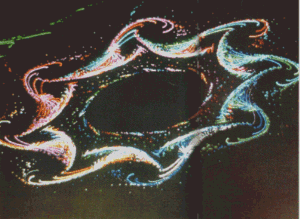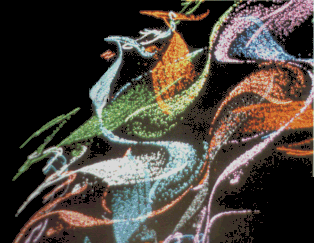
Mathematics |

In the flow : The movements of large crowds of people are not random but have distinct patterns as people head for their goal while "going with the flow".
When you are stuck in a big crowd at a pop concert or football match, it's hard to believe anything other than random pushing and shoving is going on. But according to Keith Still [Ref: Video BB14:RI2], a physics graduate and software specialist, the movement of a crowd can form beautiful mathematical patterns called fractals.[Ref: Video J3:Tomorrows World {Chaotic Crowds}]
Still picked up the first hint of these patterns at the Aids Awareness concert, held at Wembley Stadium in April 1992. Every so often the crowd would form a series of human chains.Then, just as suddenly, these would dissolve back into apparent chaos. Why were the edges moving faster than the middle? And why were the patterns so regular? He thought about it for a long time and decided that there had to be an underlying pattern.
With the help of Patrick Carr,the Operations Manager at Wembley Stadium responsible for crowd safety and security,Still gathered data on crowd dynamics during this year's FA Cup Final. From a lookout point situated high above the player's tunnel they observed the 80,000-plus crowd swarming below,and later pored endlessly over hours of video footage.
Different parts of the Wembley complex, such as the Arena and the Stadium, had completely different crowd flow patterns.But the patterns in each area stayed consistent. "We felt the solution had to be somehow fractal and that it could be modelled and hence predicted," says Still.
The video study showed that people in a crowd do have a sense of direction, but their line of sight is obscured. So they follow other people, and compete for spaces as they appear, because it is far easier to just "go with the flow" - provided, of course, that it's heading in the right general direction - rather than to try and break in to a dense Crowd. As a result,lines of people form.
Still took all the data he had gathered from observations and reduced it to a short algorithm and then applied it to a computer grid - with points representing people. The results were astonishing.Beautiful patterns,which Still christened "Orchids",suddenly grew and bloomed like flowers on the computer screen.
"We were amazed that three lines of code could produce such a complexity," he marvels.

A close examination of the Orchids using a computer "zoom lens" showed that they were fractals - basic patterns that remain similar over a wide range of scales. [Ref: Focus Jul95 p62].
The Orchids have obvious applications in predicting crowd behaviour and crowd control. But Still thinks there is more to the new fractals than simply this,pointing to the sheer number of different patterns - over 800 billion that have been generated so far by his programme.
He says: "I think we have stumbled on something other than crowd movement - but what it is we just don't know."

Flower Power : When data gathered by observing the movement of crowds was reduced to an algorithm and applied to a computer grid,it produced patterns (above) that looked like blooming flowers.So far 800 billion different patterns have been generated.
![]() Nov1984 page30.
Nov1984 page30.